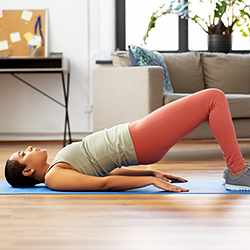
Pregnancy. Childbirth. Aging. What do all of these have in common? For women, they can all contribute to the weakening of their pelvic floor, which can cause urinary incontinence and stool leakage. However, regular Kegel exercises can help reduce accidents.
What are Kegel Exercises?
Kegel exercises help strengthen pelvic floor muscles by squeezing them, which, in turn, offers better support to your bladder and uterus. Kegels are a strengthening exercise for the pelvic floor muscles that can reduce incontinence and leaks. However, like any strengthening regimen, Kegels are most effective when performed as intended.
“Kegel exercises can help improve pelvic floor disorders when done correctly and consistently,” notes Dr. Deepali Maheshwari, DO, MPH, FACOG, urogynecologist at Baystate Urogynecology.
How to do Kegel Exercises
Kegel exercises are easy once you get the hang of them, and fairly discreet should you need to practice during your day-to-day life. These simple steps should get you started on the road to pelvic floor strength, and a more detailed description is available from our Kegel experts.
- Use the bathroom before doing Kegels.
- Find your pelvic floor muscles by squeezing your genitals only (stopping urination flow mid-stream uses the right muscles).
- Hold for 3-5 seconds.
- Relax for 3-5 seconds.
- Do 5-7 repetitions, three times a day.
As you get stronger, you can increase up to 15 repetitions. Most importantly, don’t forget to breathe normally and avoid tightening other muscles, like your stomach or legs.
While Kegels are generally considered safe to do, your doctor is a great resource for learning how to do them correctly and if they’ll benefit your specific needs.
Who Can Benefit from Kegels?
Many women can benefit from Kegels. They are typically prescribed to women diagnosed with Stress Urinary Incontinence (SUI), who might experience a small urine leak during normal bodily functions like coughing, sneezing, or laughing. Kegel exercises can also be done during pregnancy or after childbirth to improve symptoms of SUI. Women who have had surgery in their pelvic region, are overweight, are getting older, experience periodic constipation or fecal leakage, or regularly exercise may also benefit from Kegel exercises. Kegels may not be able to overcome severe urine leakage even if performed correctly. Additionally, while Kegel exercises are usually helpful, they can be harmful if done incorrectly or with a history of chronic pelvic pain.
What Are Signs That My Pelvic Floor is Strengthening?
While improvement takes time and isn’t guaranteed, if you are doing Kegel exercises correctly and consistently, you may see positive changes. Most importantly, you will notice fewer leaks and accidents. You may also find that you use the restroom less, your underwear remains dry, and you sleep better because you don’t need to get up to go to the bathroom.
Urinary incontinence, while widely experienced, is not normal, and can be treated. If you are experiencing urine leakage, have trouble doing Kegels, or have questions about your pelvic floor strength, talk to your doctor, who can offer tips or recommend other treatment options, so that you can enjoy life without worrying about incontinence.